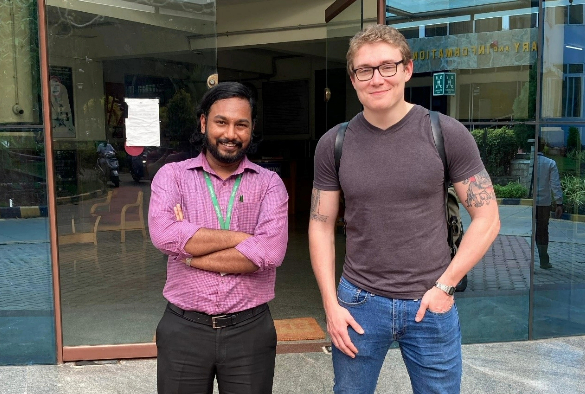
Corey Ratcliffe (pictured right, with colleague Allen Christopher, left) is a neuroimaging PhD student, three years into his project on imaging brain networks in neurocysticercosis, with a focus on identifying brain abnormalities related to seizures. Although a University of Liverpool student, Corey is based at the National Institute of Mental Health and Neuro Sciences (NIMHANS) in Bengaluru, India where he conducts his research as part of a dual PhD programme and which recently benefited from a £1.5m donation from the Pratiksha Trust, on behalf of its co-founders, Kris and Sudha Gopalakrishnan.
Psychology to neuroscience
I began with a BSc in psychology at Bangor University, which also included a year spent studying clinical psychology at Leiden University, in the Netherlands. My third-year project revolved around using functional Magnetic Resonance Imaging (MRI) to locate regions of the brain associated with social cognition, a topic within psychology that focuses on how people process, store, and apply information about other people and social situations. From this, I went on to an MRes in cognitive neuroscience at University College London, where I chanced upon a project working in epilepsy – that resulted in my first publication, a review of cognitive impairments in a subtype of epilepsy. I was later given the opportunity to join a PhD project which, although based out of the University of Liverpool, would involve the collection of data at NIMHANS— I happily accepted the opportunity to promote international collaborations.
Why study epilepsy?
One in ten people will experience a seizure in their life, with some experiencing multiple per day, or even per hour. Of these cases, around 10% can be attributed to epilepsy, a common neurological disorder characterised by a susceptibility to unprovoked/random seizure activity. Epilepsy can be found across all areas of society and has numerous potential causes, some of which are preventable and some of which arise from an obscure or unknown cause. Unfortunately, aside from managing seizures, people with epilepsy often have to deal with social stigma, restricted freedoms, and professional discrimination.
Why study neurocysticercosis?
Neurocysticercosis is a parasitic tapeworm infection, common to regions of low socio-economic status, usually in tropical regions across the globe. Tapeworm eggs travel to the brain via the bloodstream, where they lodge in the tissue and begin to die. Whilst dying, the eggs release toxins that disrupt the functioning of the local brain region. In the majority of cases, this disruption will manifest as seizure activity. Neurocysticercosis is easily treatable with medication, but seizures sometimes persist after the eggs have disappeared. As is disproportionately common among tropical diseases, due in part to the scarcity of resources in endemic regions, neurocysticercosis is considered a neglected research area. The methods and resources available to western researchers have the potential to make tremendous contributions to the shared knowledge of such cases.
How do I study epilepsy and neurocysticercosis?
Broadly, the goal of my project is to use cutting edge research techniques (such as those that have been pioneered in epilepsy studies) to find translatable features of seizures in neurocysticercosis that can be used to inform treatment decisions, and wider seizure/epilepsy research. Knowing when it’s best to treat a seizure is crucial to preventing a second episode, and due to the destructive nature of seizure activity, not a lot of the research into established epilepsy is directly applicable to individuals who are in the early stages of a seizure disorder. As previously mentioned, epilepsy has many possible causes, and in recent years related research has shifted to a network perspective, where brain regions function (or dysfunction) as part of dynamic and distributed networks, as opposed to independent structures. Network exploration is made easier by using ‘big data’, such as MRI scans which can be interrogated quantitatively. My supervisors and I hope that by exploring brain networks associated with seizures in patients with neurocysticercosis, we can identify factors in the brain environment that may predispose to seizure activity, without the interference of chronic seizure activity or anti-seizure medication.
Finishing a PhD, starting something bigger
I spent a year living at NIMHANS. Much of this time was spent organising and refining the process of data collection, which is still ongoing at the moment as part of a collaborative effort between my two institutes — a partnership that extends to other areas, such as brain infections and child health research. The rest of my PhD will be spent processing and analysing this data, which will be used to model outcome probabilities depending on early observable characteristics. By using advanced MRI to examine a neglected disease, we are exploring new ground, and are optimistic that it will provide insight on not only the treatment of neurocysticercosis and epilepsy, but also seizures in a broader context. In a broader-still context, I’m proud to be part of a research programme that is willing to look beyond our walls and borders in search of answers, one that is mindful of the strengths that different perspectives can offer, one that is willing to pool together complementary researchers and resources to achieve a common goal. The opportunities that I have had as part of my PhD, in both Liverpool and Bangalore, mean that while I may not be an expert (yet), I’m certainly closer than I was yesterday, and will be closer still tomorrow.